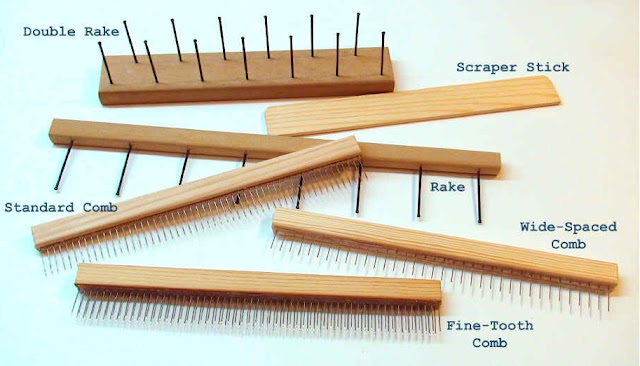Without getting too historical, scientific, or mathematical there are some relationship to the patterns created in 2-D paper marbling designs that predate modern marbling (albeit hundreds of years old) by thousands of years. I see combed patterns in ancient blown glass that are 'dragged'. Master marbler Dan St. John sees elements of combed marbling in the machinery and mechanics of weaving. But keeping to a discussion of the variety marbling combs and rakes used by marblers will be hard enough.
 |
| Combs and rakes from Galen Berry's marbling supply site https://marbleart.us/MarblingSupplies.htm |
Simply put, a marbling comb has tines that are closer together than a marbling rake. Galen Berry's site sells a selection that shows the elementary examples of combs and rakes including the first variation of the single row comb/rake, the 'double rake' with two rows of tines that are offset.
Another type of comb has a irregular alignment or spacing of the teeth. Rather than equal interval or space between the tines there are combs that create uneven space in patterns. Below, the Dan and Regina St. John's Facebook page are examples of combs with different spacing if teeth.
Right away the discussion of combs has to go to how a pattern of COMBING is done. Starting with the movement horizontal versus vertical to side to side or even which comb to use in which order. Dan St. John loves to test his friend by posting a example of a marbled pattern he has done and then asks his friends and followers how he created the distinct pattern. I am amazed when other marblers like Iris Nevins nails the answer with a complicated recipe of moves and identification of tools that created the pattern in question. Iris, being an accomplished musician, somehow brings another analytical skill set to a visual problem. In a way marbling is visual music and combs are the keyboards and chords that make it happen.
A speculative example of a marbling I offer is on that might change pattern on the surface of the marbling tank thedeeper it is moved through the water (sizing).


No comments:
Post a Comment